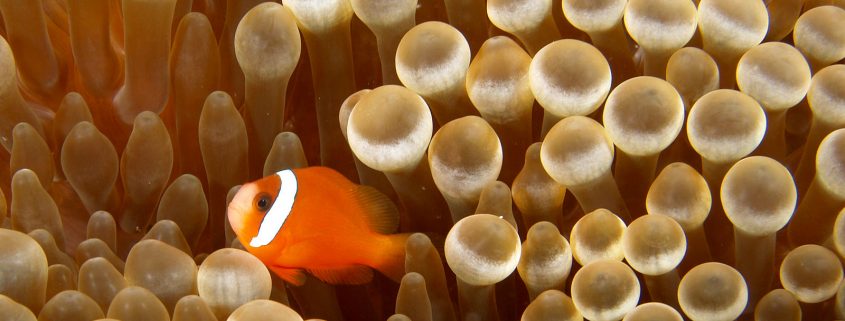By Leila AtallahBenson, SRC master’s student
![A Nemo lookalike in close proximity to an anemone host. [Wikimedia Commons]](https://sharkresearch.rsmas.miami.edu/wp-content/uploads/2017/04/Firgure-1-300x221.jpg)
A Nemo lookalike in close proximity to an anemone host. [Wikimedia Commons]
Do you remember in Finding Nemo when the eagle ray professor asks the kids where they live, and nemo replies, with some difficulty, that he lives in an anemone? Have you ever wondered about the relationship between the clownfish and their anemone homes? It is known that these two species interact and have a mutualistic relationship. Anemones house and protect clownfish, but what do clownfish do for the anemone? Well, a group of researchers from Boston University took a deeper look at the association of clownfish and anemones.
They conducted a one-and-a-half-year study, where they placed 0, 1, or 2 clownfish in a tank with an anemone. They watched the fish personalities over the course of the study. Fish personalities were described by how much time a fish spent near their anemone home: were they a shy fish, like Nemo’s dad Marlin, and spent most of their time in or around their anemone? Or were they a more outgoing fish, like Nemo, and adventured away from their anemone? They then recorded what growth effects these different personalities had on the anemones.
![Predicted anemone growth given the shyness of a fish over the year-and-a-half study. Maximum shyness of a fish is 1200 sec. [Schmiege et al. 2017]](https://sharkresearch.rsmas.miami.edu/wp-content/uploads/2017/04/Figure-2-300x232.png)
Predicted anemone growth given the shyness of a fish over the year-and-a-half study. Maximum shyness of a fish is 1200 sec. [Schmiege et al. 2017]
As it turns out, shyer fish help anemones show more growth. Anemones with fish residents that spent more time near to them grew significantly more than anemones whose fishy friends spent more time adventuring away from their homes. The scientists proposed that this relationship is seen between shy fish and anemone growth because shy fish provide more oxygenation, nutrients, and freedom to stretch the anemone’s tentacles and feed for themselves. Shy fish swim and move around the anemone more frequently, bringing oxygen to the anemone. Given shy fishes’ increased presence, there is also more fish waste for the anemone to absorb nutrients from. Shy fish are also around to defend their hosts more, which allows the anemone to stretch out its tentacles and absorb more nutrients from the water column. Maybe that’s why Nemo and Marlin’s anemone was the same size when they came back from their adventure, it did not have its shy, fishy friends to help it grow.
![An anemonefish next to an anemone, Entacmaea quadricolor, the kind used in the study. [Wikimedia Commons]](https://sharkresearch.rsmas.miami.edu/wp-content/uploads/2017/04/Figure-3-300x225.jpg)
An anemonefish next to an anemone, Entacmaea quadricolor, the kind used in the study. [Wikimedia Commons]
Schmiege, P.F.P., D’Aloia, C.C., Buston, P.M. 2017. Anemonefish personalities influence the strength of mutualistic interactions with host sea anemones. Marine Biology 164:24.
![A Nemo lookalike in close proximity to an anemone host. [Wikimedia Commons]](https://sharkresearch.rsmas.miami.edu/wp-content/uploads/2017/04/Firgure-1-300x221.jpg)
![Predicted anemone growth given the shyness of a fish over the year-and-a-half study. Maximum shyness of a fish is 1200 sec. [Schmiege et al. 2017]](https://sharkresearch.rsmas.miami.edu/wp-content/uploads/2017/04/Figure-2-300x232.png)
![An anemonefish next to an anemone, Entacmaea quadricolor, the kind used in the study. [Wikimedia Commons]](https://sharkresearch.rsmas.miami.edu/wp-content/uploads/2017/04/Figure-3-300x225.jpg)




Leave a Reply
Want to join the discussion?Feel free to contribute!